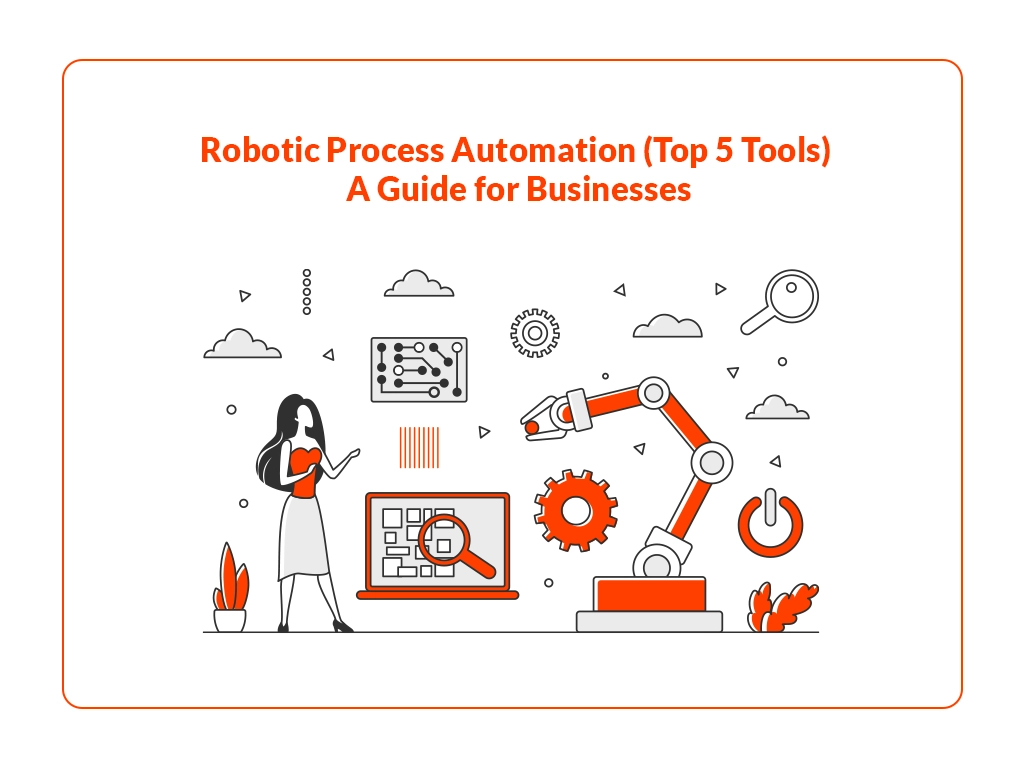Robotic Process Automation (Top 5 Tools): A Guide for Businesses
Discover the best RPA tools and how they can revolutionize your business processes. Learn about UiPath, Automation Anywhere, Blue Prism, and more.

Imagine a world where all your repetitive, time-consuming tasks are handled by intelligent robots, freeing you to focus on more strategic and creative work. With Robotic Process Automation (RPA) tools, this vision is no longer a fantasy—it’s a reality that’s transforming the way businesses operate. RPA tools are revolutionizing the way businesses operate, reducing errors, saving time, and boosting overall efficiency. Automating and assisting businesses saves time and resources, daily processes, and workflows which assists employees to work on more complex activities.
Let’s discover the top Robotic Process Automation tools, their advantages, and the trending automation tools that are shaping the future of business operations.
What is Robotic Process Automation?
Robotic Process Automation is a software tool that automates repetitive tasks in the same way humans would interact with digital systems from invoice processing and data entry to customer service. RPA tools lessen the necessity for human intervention which leads to cost savings and improve accuracy in business processes.
Deloitte in Focus
Deloitte, a global consulting firm, implemented RPA to streamline its internal invoice processing. Prior to RPA, the company relied on manual data entry to process thousands of invoices from various vendors, a process that was prone to errors and delays.
By deploying RPA, Deloitte created software bots that automatically extracted invoice data, validated it against purchase orders, and input the information into their accounting system. This automation reduced manual intervention, minimized errors, and sped up the invoice processing time from days to just a few hours.
Outcome:
- Efficiency Gains: Deloitte was able to process invoices 60% faster.
- Cost Savings: The automation reduced labor costs associated with manual processing.
- Accuracy Improvement: The error rate dropped by over 90%, eliminating costly mistakes.
Top RPA Tools to Consider
When seamlessly using Robotic Process Automation Tools in your business using the right tool is necessary. Let’s see the top trending RPA tools that are currently popular in the market:
1. UiPath
UiPath is well-known for its simple, drag-and-drop interface which allows users to automate tasks without any requirement of coding experience, also it is majorly used in several sectors such as healthcare, finance, and retail sectors which makes it a convenient option for businesses that are looking to automate workflows effectively.
Pros:
- User-Friendly Interface: Drag-and-drop design makes it user-friendly to non-developers.
- Broad Application: Broadly used across several industries like healthcare, retail, and finance.
- Strong Community: Active community for support and resources.
- Scalability: Can be adaptable from small to enterprise-level automation.
Cons:
- Cost-Intensive: Licensing can be costly mostly for small businesses.
- Resource-Intensive: Substantial demands on system resources.
- Steep Learning Curve: Complex features might need specialized training for advanced use.
2. Automation Anywhere
Automation Anywhere is known for its advanced automation features which consist of machine learning and AI integration which can manage both complex and simple processes by making it suitable for all scales of businesses.
Pros:
- Advanced Automation: Features machine learning (ML) and AI integration.
- Versatile: Handles both simple and complex processes.
- Suitable for All Scales: Works well for businesses of any size.
- Cloud-Based: Offers cloud and on-premise solutions.
Cons:
- High Cost: Licensing and implementation can be quite costly.
- Requires Skilled Personnel: Advanced features might require specialized knowledge.
- Performance Issues: Can experience lagging issues in complex automation
3. Blue Prism
Blue Prism is a potential tool used by various large enterprises due to its high levels of security and scalability features and it provides cloud-based solutions that allow businesses to automate operations on a large scale which helps businesses to grow.
Pros:
- High Security: Strong security features for data-sensitive industries.
- Scalability: Suitable for big businesses that require extensive automation.
- Cloud-Based: Flexible deployment which includes cloud solutions.
- No Code Required: Allows automation without coding knowledge.
Cons:
- Costly Licensing: Costly especially for smaller organizations.
- Requires Expertise: Mostly requires specialized RPA developers for implementation.
- Limited to Large Enterprises: This might not be as flexible for small-to-medium businesses.
4. Kofax RPA
Kofax RPA succeeds in automating large volumes of documents such as invoice processing and compliance checks. It is integrated with AI for maintaining unstructured data which makes it a beneficial tool for companies that handle large volumes of document workflows.
Pros:
- Document-Centric: Excellent for automating large volumes of documents.
- AI-Integrated: Handles unstructured data efficiently.
- Specialized in Compliance: Effective for industries requiring extensive compliance checks.
- Reduces Manual Effort: Does not require human intervention in data-intensive tasks like invoice processing.
Cons:
- Limited Community Support: Fewer resources and a less user community as compared to other RPA tools.
- Complex Setup: Implementation can be time-consuming and needs expert configuration.
- Higher Costs: Licensing and maintenance fees may be steep
5. Pega
Pega provides an integrated Robotic Process Automation solution within its digital transformation suite which makes it a best option for businesses who want end-to-end automation. Its strongest point lies in customer service which seamlessly integrates with customer relationship management (CRM) systems.
Pros:
- End-to-End Automation: Integrated RPA within its digital transformation suite.
- CRM Integration: Seamlessly connects with CRM systems which makes it perfect for customer service.
- Customizable: Highly convenient to certain business needs.
- Advanced AI Features: Leverages AI to optimize workflows.
Cons:
- Expensive: High upfront costs for licensing and implementation.
- Limited Usability: Ideal for businesses who are already using Pega’s ecosystem.
- Steep Learning Curve: Needs specialized training and technical expertise.
Benefits of Robotic Process Automation Tools in Business Processes
Let us discover several benefits of Robotic Process Automation tools:
1. Increased Efficiency:
It assists employees to work on more strategic work by automating complex processes.
Example: Deutsche Bank a prominent global financial institution used RPA to seamlessly streamline its accounts payable process. The bank’s employees previously dedicated hours every day manually processing invoices and financial transactions.
Outcome: Deutsche Bank automated these processes by reducing manual processing time by 60% which allows employees to focus on prioritizing tasks such as financial analysis and strategic decision-making which mostly enhances overall operational efficiency. (SpringerLink) (Data Art)
2. Improved Accuracy:
RPA removes human error which results in more precise task completion.
Example: Deloitte, a global consulting firm, utilized RPA to streamline its audit and compliance processes. Prior to automation, Deloitte’s audit teams spent significant time on repetitive tasks such as data extraction and validation, which were prone to human errors.
Outcome: By implementing RPA, Deloitte achieved a 90% reduction in errors in its audit processes. The automation of data handling and report generation led to more accurate and consistent audit results, allowing for more reliable compliance assessments and reducing the time required for audit completion. This improvement in accuracy also facilitated better risk management and enhanced client satisfaction. (Ui Path)
3. Scalability:
Businesses can expand their automation as they grow.
Example: IBM, a multinational company used RPA to automate its customer service operations. As the company scaled globally, IBM was required to scale its customer service processes without any need for adding more employees.
Outcome: IBM expanded its customer service processes by supporting ticket management and automating routine inquiries which allows the company to manage rising demand without causing personnel growth. This scalability improved customer satisfaction and minimized operational costs.
4. Enhanced Compliance:
Several RPA tools contain inbuilt compliance features which assist businesses meet regulatory needs.
Example: Zurich Insurance a renowned insurance provider implemented RPA to improve compliance in its claims processing operations. With strict legal policies in the insurance sector, they needed to make sure all claims were according to legal standards.
Outcome: Zurich achieved 100% compliance by integrating RPA with legal standards in its claims processes by minimizing the risk of fines and legal issues. The automation also speeds up processing which enhances operational reliability and customer experience. (Altoros) (MDPI)
Key Considerations for RPA Implementation
Seamlessly implementing Robotic Process Automation tools requires a systematic approach. Below are some important points to remember:
1. Identify the Correct Processes
By automating tasks that follow the standards from report generation to data entry to make sure you get the most from the tools.
2. Choose the Right Tool
Choose a tool that pairs well with your business requirements and budget which efficiently can streamline your workflows and improve ROI and start with smaller processes to allow your team to conveniently adapt to the technology and once you have achieved initial success, grow up to more complex operations.
3. Monitor and Optimize
Robotic Process Automation tools require constant monitoring and optimizing data for automating processes to ensure optimal efficiency.
Automation Technology Trends to Watch
Robotic Process Automation sector is evolving day by day with several technologies that will help to transform the future of automation:
1. AI Integration:
RPA tools are integrating AI to maintain unstructured data and promote smarter decision-making which leads to deeper digital transformation.
Use Case:
Unilever used cloud-based RPA to maintain its global supply chain operations. Unilever was able to expand its automation efforts with the flexibility of the cloud in various regions without any requirement for local IT infrastructure which led to faster deployment, simpler updates, and increased efficiency in supply chain management.
Fact:
According to Deloitte 73% of organizations that use RPA wish to integrate AI in the next 3 years to maintain unstructured data and drive smarter decision-making.
Forecast:
AI-integrated RPA tools by 2025 will maintain up to 50% of unstructured data in enterprises according to Forrester which will allow organizations to automate more complex, cognitive tasks which will scale automation’s role across industries.
2. Cloud-Based RPA:
More businesses are adopting cloud-based RPA for its flexibility, scalability, and ease of deployment, as companies move more systems to the cloud.
Use Case:
Unilever adopted cloud-based RPA to manage its global supply chain operations. With the flexibility of the cloud, Unilever was able to scale its automation efforts across different regions without requiring extensive local IT infrastructure. This resulted in faster deployment, easier updates, and increased efficiency in supply chain management.
Fact:
A report by Gartner reveals that by 2024, 60% of new RPA deployments will be cloud-based due to their ease of deployment, cost-effectiveness, and scalability.
Forecast:
As cloud adoption continues to rise, IDC predicts that the global cloud-based RPA market will grow by 35% annually, reaching a market size of $5.5 billion by 2025. Businesses will increasingly move away from on-premises solutions to cloud-based RPA for greater flexibility and operational agility.
3. Hyperautomation:
Hyperautomation combines Robotic Process Automation tools with AI and machine learning, which traction and this strategy automate as many processes as possible which pushes automation to its next level.
Use Case:
Siemens implemented hyper-automation by combining RPA with AI and machine learning to automate its entire accounts payable and procurement process. The technology enabled end-to-end automation, from receiving invoices to making payments, without any human intervention.
Stats:
According to a Gartner survey, by 2024, organizations that adopt hyper-automation will see operational costs reduced by 30% through automation of tasks previously thought too complex to automate.
Forecast:
By 2025, Gartner predicts that hyper-automation will be one of the top strategic technology trends, with 70% of large enterprises adopting hyper-automation technologies to manage complex workflows and reduce manual labor across industries.
Robotic Process Automation Tools Implementation Strategy
A clear strategy is crucial for successful Robotic Process Automation Tools implementation. Follow these steps:
1. Assess:
The initial phase is to determine which processes and tasks in your organization can benefit from automation and look for complicated and repetitive tasks that do not require much decision-making but still take a lot of staff hours. These are mostly found in areas like invoice processing, data entry, or customer service inquiries. .
Example:
By automating the process of sending out monthly reports. If employees are manually formatting reports, collecting data, and mailing them out then this is a suitable candidate for automation.
By initiating tasks like these you could free up your team’s hours for more creative and strategic work, which helps boost both job satisfaction and productivity.
2. Plan:
Once you have recognized which tasks to automate then it is necessary to have a well-defined plan, set significant goals, and what do you want to accomplish by RPA? Do you want to cut costs, enhance efficiency, or minimize errors?
Create a timeline that describes the stages of your execution and ensure to allocate resources both in terms of personnel and budget. Recognize who will be in charge of managing the project, and make sure that team members are trained in using the new tools.
3. Execute:
When you are ready to launch then start by automating the easiest tasks first, which gives your team time to adapt to the new system and minimizes the risk of running into unknown issues early on. Once these easier processes are running seamlessly then you can instantly automate more complex workflows.
Example:
Initiate by automating basic data entry tasks such as transferring customer details from the CRM system to email. Once you have perfected that then move on to automating more advanced tasks like customer service workflows or inventory management that contain AI-based chatbots. Taking a systematic way of approach assists in reducing disruptions and progressing toward larger-scale automation.
4. Review:
After implementation, daily review the performance of your RPA tools to make sure they are working as expected. Look at key parameters like error rates, processing time, and employee productivity to determine if the automation is meeting your initial goals. Automation tools can be customized to suit your requirements over time. As your business progresses so should your RPA strategy.
Conclusion
Robotic Process Automation tools are transforming how businesses operate by reducing costs, boosting accuracy, and enhancing overall efficiency. Selecting the right RPA tools, such as UiPath, Automation Anywhere, or Blue Prism, can create a difference in how well your business uses automation. Using Robotic Process Automation tools effectively and pairing them with your business processes will assist you stay competitive and fully accepting the advantages of digital transformation.
By using Robotic Process Automation tools in your organization, you can streamline operations, reduce human error, and focus on strategic growth. Ready to take the next step? Explore our articles on RPA implementation strategies and automation technology trends to learn more….



